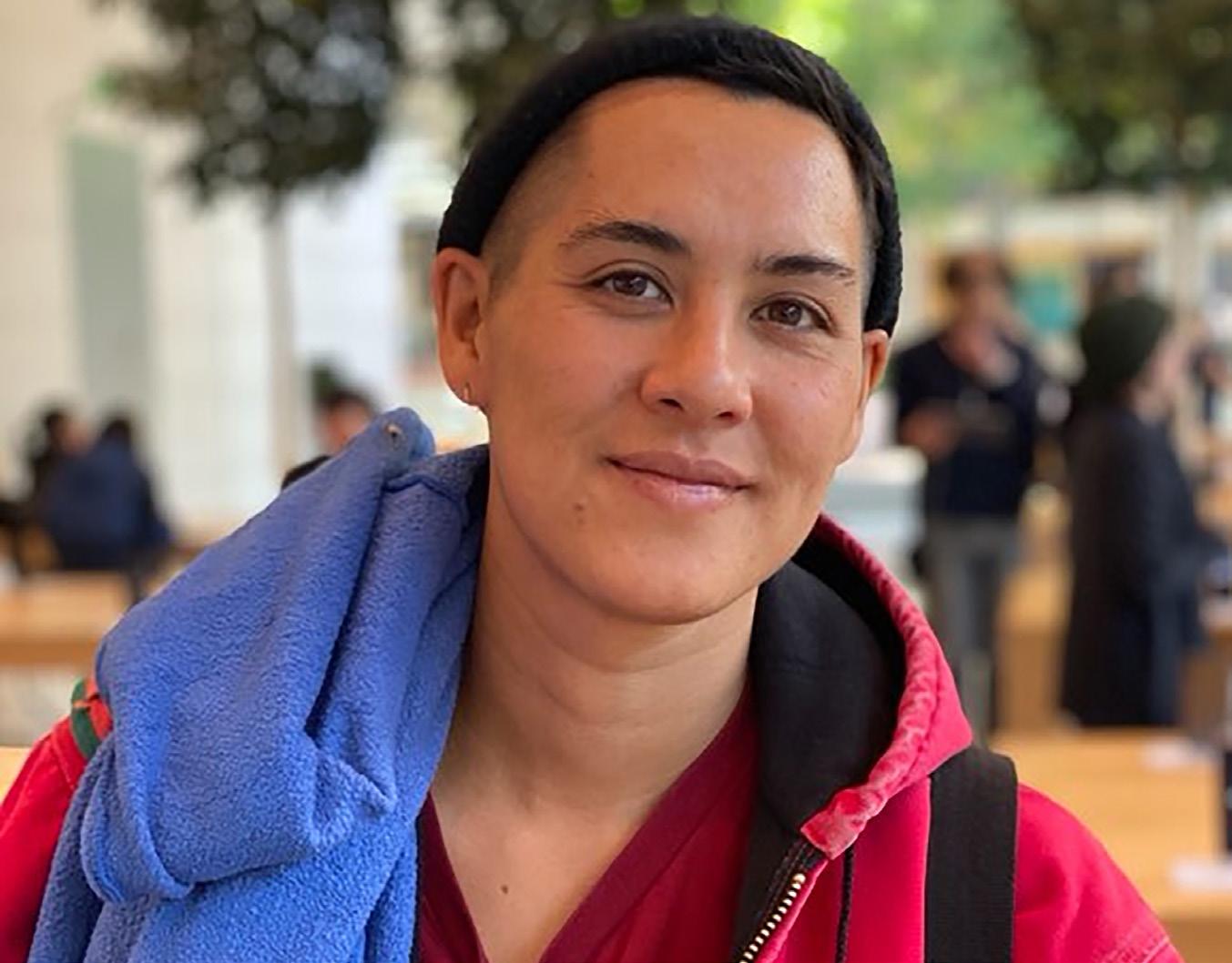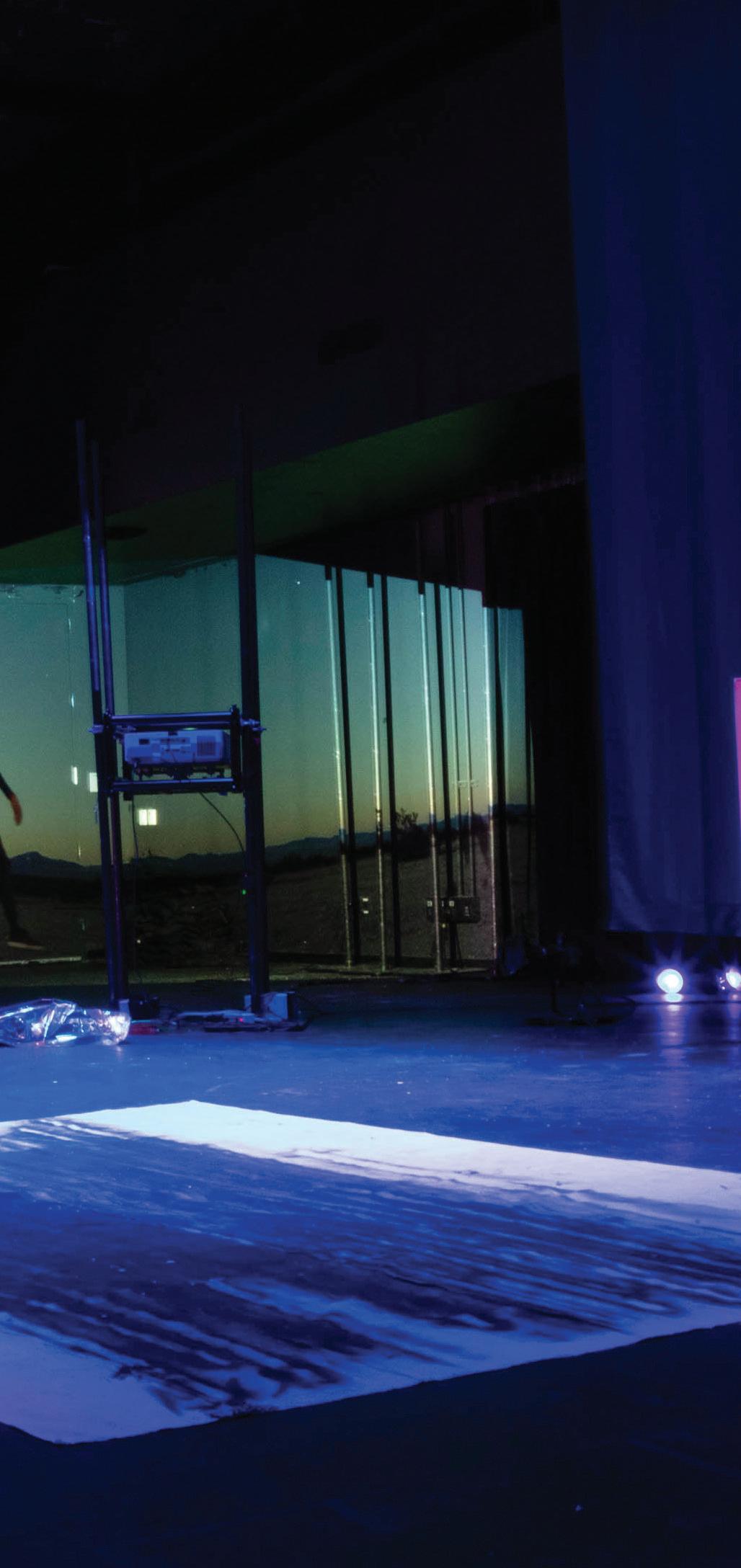
8 minute read
STUDENT RESEARCH
Artist for the Future
Gabby Miller, M.F.A. ’20, crosses disciplines to explore the possibility of a future that is not predetermined
By Christine Byrd
“Can we turn the Black Box Theatre into an Oracle Machine?” was a question burning in Gabby Miller’s mind during the final year of her M.F.A. program at the Claire Trevor School of the Arts.
Miller seized the opportunity to explore the question in the Experimental Media Performance Lab (xMPL), in a project that, in hindsight, seems especially prescient. Who among us isn’t now seeking answers from an uncertain and fragile future? For three weeks in January, Miller transformed the xMPL, a black box theater, into an immersive experience where artists and visitors alike could seek answers, and extend their questions. A hologram of Dolly Parton belted “Jolene,” a saxophone tune mysteriously moved around the room, and a projection of Jehbreal Jackson, M.F.A. candidate in dance, floated above a pile of rocks in a corner. “Jehbreal could stand in as the oracle of Delphi,” says Miller, who drew from ancient Greek thinkers in her work. “At Delphi, a priestess went into a trance, supposedly breathed vapors from a cleft in the rocks, and delivered messages from Apollo to those who wished to read the future.”
She adds, “I grounded this research in the classics, turning to Aristotle as the progenitor of the fiction of narrative. This pervasive belief that there is a beginning, a middle and an end. The assumption that there is a conclusion to the story.”
Miller invited two dozen artists and non-artists to participate — from dancing to singing karaoke. She recorded and incorporated them into projections around the theater, layering and evolving the project. Central to her approach was keeping an openended dialogue — experimenting with how to permit a future that is not predetermined. “Gabby was experimenting the whole time and building off of other programming that was already happening in the school in art, music and dance,” says Eden Phair, director of interdisciplinary programs. “This was the first time an artist has used the xMPL as a residency space, and it was really exciting.” Yet the xMPL is far from the most unusual place Miller has taken up an artistic residency.
Image (opposite page): Inside the “Oracle Machine,” an art installation by Gabby Miller.
Image: Gabby Miller, photo by Sam Richardson.
Transpacific Travels
In 2015, Miller traveled from California to China in a cargo ship, where she developed “Turquoise Wake (Coal, Air, Chicken & Shit)” which explored how people, goods, and power move across the Pacific through art that included paintings of crew members’ photos from home made from the ship’s heavy crude engine oil. Born to a Vietnamese mother and an American father who met during the Vietnam War, Miller has been continuously investigating the relationships between East and West. As an undergraduate studying anthropology at Reed College in Oregon, she took a break from school to spend time in Hanoi with her mother and sister, where she became involved in the Nha San Collective, a prominent experimental art space.

Over the course of a decade, Miller worked in Vietnam’s art scene, writing, organizing and helping bring artists from Vietnam to work on projects in the U.S. Her research led her to contemplate how the supply demands for the Vietnam War catalyzed the adoption of container shipping around the world. That idea eventually brought her aboard the CMA CGM Gemini cargo ship in a self-directed artist residency supported by the Asian Cultural Council. “I was profoundly shaken by my trip across the Pacific, and the understanding of being in the middle of an apocalyptic mass ecological disaster,” Miller says. “When I returned, I wanted to be in a university setting to think about it, to work with other people, and also to create solitude to be able to explore these urgent issues.”
UCI’s art department appealed to Miller’s desire to work across disciplines. Not only has she worked with an array of artists in other departments within the Claire Trevor School of the Arts, she has audited Earth system science courses in the School of Physical Sciences, and taken anthropology and critical theory courses in the School of Humanities.
In 2018, she won a Medici Circle Scholarship to work with UC Santa Cruz anthropologist Anna Tsing at Aarhus University in Denmark. Miller spent the following year working with Tsing and a trans-disciplinary team of scientists, anthropologists, artists and designers to help build an online interactive platform called The Feral Atlas.
Digging Deeper
While her parents’ Transpacific ties motivated Miller’s early work, it was an earlier generation that inspired much of her projects at UCI to focus on the subterranean, exploring themes of mining and oil extraction.
Image: The Experimental Media Performance Lab (xMPL) is transformed into the “Oracle Machine.”
Photo: Sam Richardson

Miller’s great grandfather, a mining engineer, helped fund Spoor’s Spectaculum, a huge movie theater at “A Century of Progress,” the 1933 Chicago World’s Fair. Despite its 1,500 seats, a screen six times bigger than usual, and a 13 minute movie of Niagara Falls featuring new 3D technology, the theater was a spectacular flop. More than 46 million people visited the fair, but hardly any came to the show. Playing with the idea of failed progress and the spectacular, Miller built a

darkened mineshaft space in the Room Gallery at UCI. She inserted miniature black boxes with archival images from the theater and used a “pepper’s ghost” illusion technique so that an image of herself appeared, half nude, inverted in a handstand with Niagara Falls in the background. Initially, Miller wanted to scale up this idea of her grandfather’s project in the xMPL, but then she became interested in the fundamental concept of a black box, with its visible inputs and outputs,
Photo: Sam Richardson

but unseen interior operations. This led her to the term “oracle machine,” a concept used by computer engineers. “What if we had a machine that could instantaneously give us the answer to exponentially hard questions?” Miller asks. “I developed this guiding question to turn my time in the xMPL into a dialogue, in opposition to this determined nature of my great grandfather’s work in the Century of Progress.” Miller closed the oracle machine project with a series of tarot readings about climate change brought about by previous generations’ preoccupation with progress.
“Gabby turned a traditional black box theatre into an oracle machine which was, in fact, a wormhole, with the purpose to communicate with enlightened beings from different galaxies. The series of events and exchanges that took place in the oracle machine were designed to transcend three-dimensional existence,” says Daniel J. Martinez, professor of art, Miller’s thesis advisor and closest mentor. “Gabby is asking us to consider and reflect upon the possibility of how to reimagine our own humanity,” Martinez adds.
Miller has several exhibits scheduled later this year, including “A Place Beyond” at the Yerba Buena Center for the Arts in San Francisco. She also continues serving as a board member of the Dhamma Dena Meditation Center in Joshua Tree. Despite graduating during a time of tremendous uncertainty, her questions about the future, our relationship with the planet, and the very nature of our humanity are more pressing than ever.
Learn more about the department of art, upcoming exhibitions, and student research at art.arts.uci.edu.
New books from faculty in the Claire Trevor School of the Arts
Anxious Creativity: When Imagination Fails
By David Trend, professor of art Creativity is prized, yet it reveals fault lines in U.S. culture. People see creativity as a desirable trait and a work enhancement, yet most say they just aren’t creative. Businesses see creativity as essential to productivity and growth, but also avoid risk. Trend untangles this conceptual mess, showing how America’s edginess dampens creativity. Written engagingly, the book addresses the knotty problems of reconciling the expressive potential in all people with the nation’s tendency to reward only a few. The solutions to America’s creativity crisis lie in rethinking concepts of individualism, competition, and the ways creativity is recognized and rewarded.
Available in hardback and as an eBook. 2019, 326 pages; Hardcover ISBN: 978-0-367-27506-8; Paperback: 978-0-367-27509-9; eBook: 978-0-429-29643-7
Louise Brigham and the Early History of Sustainable Furniture Design
By Antoinette LaFarge, professor of art During the Progressive Era (1890s - 1920s), a time when the field of design was dominated almost entirely by men, a largely forgotten activist and teacher named Louise Brigham became a pioneer of sustainable furniture design. With her ingenious system for building inexpensive but sturdy “box furniture” out of recycled materials, she aimed to bring good design to the urban working class. As Antoinette LaFarge shows, Brigham forged a singular career for herself that embraced working in the American and European settlement movements, publishing a book of box furniture designs, running carpentry workshops in New York, and founding a company that offered some of the earliest ready-to-assemble furniture in the United States. Her work was a resounding critique of capitalism’s waste and an assertion of new values in design — values that stand at the heart of today’s open and green design movements.
Available in hardback and as an eBook. 2019, 149 pages, 35 illustrations; Hardcover ISBN: 978-3-030-32340-0; eBook: 978-3-030-32341-7





